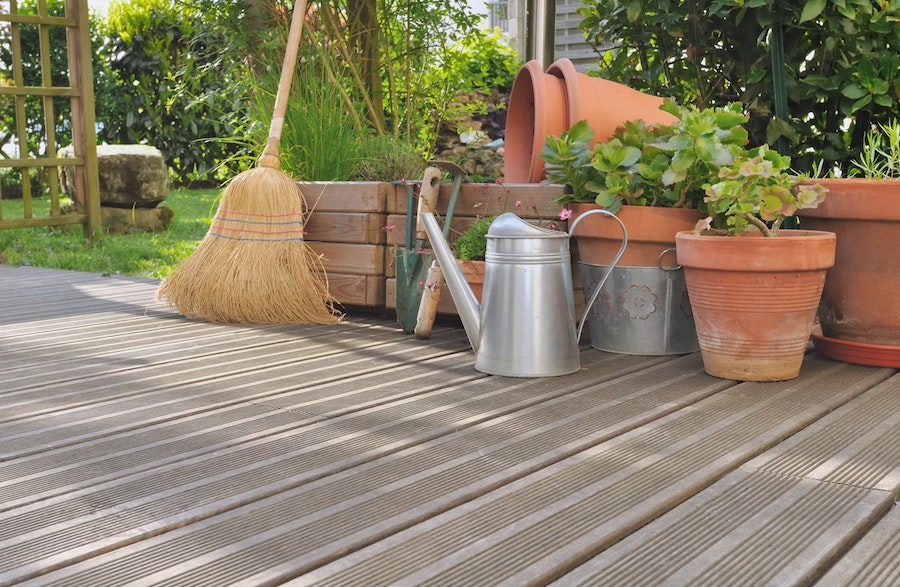8 tips for giving your garden a late summer spruce-up
Back from your summer travels? Are your hanging baskets looking a little sorry, your pots pathetic and your borders brimming with weeds? Here are some easy but effective garden tidy-up tips…
1. Save it…

Cut back perennial Michaelmas daisies, which will return next year
Save what you can, deadheading late-flowering blooms in borders which may come back to life. Perennials which have finished flowering can be cut back but will come back to life next year. Established trees and shrubs won’t generally have been damaged in your absence.
2. Ditch it…
If your hanging baskets and pots of annuals have completely dried out, take them down and empty the contents onto the compost heap. Keep your spirits high by buying spring-flowering bulbs and, if you want late colour, pop into the garden centre to find some.
Good plants which will bring colour at this time of year include asters, chrysanthemums and nerines, along with rudbeckias and sedums. Plant some in the pots that are now free from wilted summer annuals.
3. Tend to the lawn…

If the grass has started to grow, mow it with the blades high
With the hot summer we’ve had, the lawn might be looking like hay and shouldn’t need cutting. If it has grown substantially though, leave the blades on the highest setting for the first cut, reduce the height at the next a few days later, and then cut at the normal height. You’ll be surprised how much tidier the garden looks when the lawn has been mown. Take time to tidy up the lawn edges using edging shears.
4. Lose the weeds…

Keep weeds at bay
Look over your beds and borders and if weeds have sprung up, then get rid of them quickly. Seeds shed at this time of year, which means more work later on. Keep on top of deadheading, otherwise the flowering will not continue as long as you’d like.
5. Harvest now…

Harvest veg and freeze them
If you have a vegetable patch, harvest as much ripe produce as you can now, to stop the veg running to seed or becoming over-ripe. You can blanch (immerse in boiling water) and freeze many veg, including green beans and sweetcorn, so you don’t end up wasting what you pick.
Immerse the vegetables immediately into a bowl of iced water after blanching, to stop them continuing to cook. When cool, lift the veg from the iced water, spread out on a kitchen towel and pat dry to remove excess moisture. Pack loose vegetables in resealable plastic bags or other containers.

Harvest tomatoes for using in sauces and soups later
Vegetables suitable for freezing include beans, broccoli, cauliflower, corn, peas, spinach, Swiss chard and summer squash. Even tomatoes can be frozen whole and then used in sauces and soups later on.
6. Clear space for new crops…
Find time to clear vacant rows in the veg patch and refill them with autumn and winter crops as soon as you can.
7. Put away pots for winter…

Tidy up flower pots and discard those which are cracked and broken
If you have empty pots you’re not going to use again this year, clean them with diluted disinfectant and stow in the shed for winter. That way, terracotta won’t crack and other vulnerable pots won’t perish when the frost comes. Also, remove and put away stakes which propped up plants which have now been cut back.
8. Plan for next year…
Take time to write a list of what you are going to include and exclude in your plantings next year. Look for gaps you’ll need to fill in borders next season, and maybe extend the season by planning to plant some perennials which provide late-summer colour.
The Press Association
Latest posts by The Press Association (see all)
- Maple Cinnamon Granola - January 8, 2025
- 8 things your feet can tell you about your health - January 8, 2025
- 9 ways to look after your emotional health better in 2025 - January 7, 2025
- EastEnders fans to vote on storyline for the first time in 40th anniversary week - January 7, 2025
- Aldi beats rival Lidl as cheapest supermarket of 2024 - January 6, 2025





















